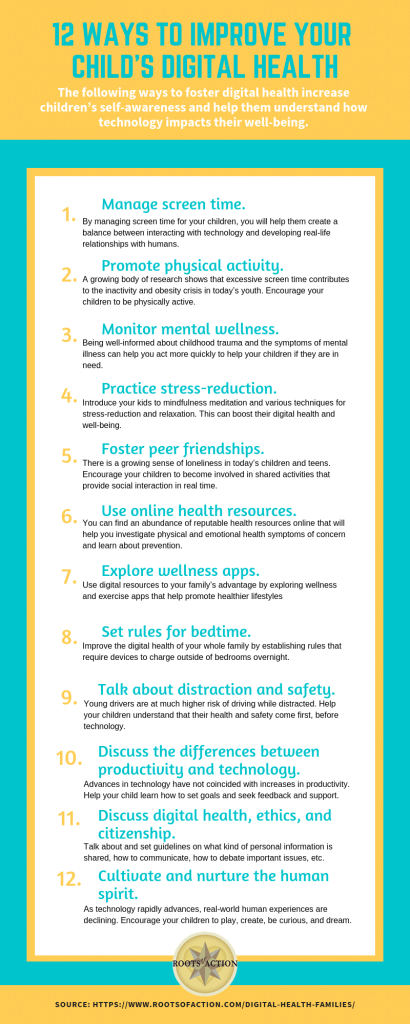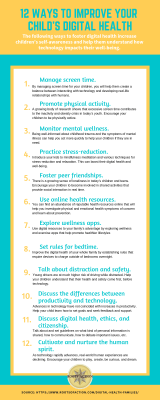
The field of digital health and wellness is expanding rapidly to include a wide variety of topics that are of interest to parents. Originally related to healthcare delivery and how technology could be used to improve patient care, digital health must be viewed more broadly to include the psychological well-being of children growing up in the Digital Age.
Digital health and its related technologies empowers families to better track and manage their healthcare, gain access to health-related information, and live more productive lives. Ironically, as technology begins to transform healthcare delivery, the overuse of technology by children and adults produces new health concerns, both physical and psychological.
How to address these health concerns has become an increasingly important topic for researchers. Yet studies cannot keep up with the pace of accelerating changes in technology. In many ways, researchers are swimming upstream, attempting to adapt to constantly changing currents and conditions.
According to a newly published report by the Global Wellness Institute, Wellness in the Age of the Smartphone, “Whether we like it or not, whether we feel confident that we can deal with the change or not, this technological revolution will disrupt everything in a trend that is inescapable. Its scale, speed, breadth and complexity will be unlike anything we’ve experienced before.”
Most studies on the digital health and emotional well-being of children agree there are benefits and pitfalls of smartphone usage. But there is not global agreement on just how technology will change the lives of future generations. In this new 29-page report and review of current research, good information can be gleaned for parents. While there is much uncertainty on how technology and smartphones will impact child and adolescent development, the latest data suggests intelligent ways to promote the digital health and wellness of your children and teens.
The following ways to foster digital health increase children’s self-awareness and help them understand how technology impacts their well-being. As they grow to adulthood, they will have the internal resources to both manage their own use of technology and determine how technology can help improve their lives.
12 Ways to Improve Your Child’s Digital Health
1. Manage screen time.
When parents manage screen time for kids, they help children discover other healthy ways to find meaning in life. Kids create a balance between interacting with technology and developing real-life relationships with humans.
2. Promote physical activity.
A growing body of research shows that excessive screen time contributes to the inactivity and obesity crisis in today’s youth. Learn how nature fosters happiness, and encourage your children to be physically active.
3. Monitor mental wellness.
Researchers have associated the growth of social media and technology use with rising rates of depression, anxiety, and suicide. Parents who are well-informed about childhood trauma and the symptoms of mental illness can act more quickly to help children in need.
4. Practice stress-reduction.
The Global Wellness report says, “the biggest challenges to mental wellness appear to come, not from the technology itself, but from the added pressures and pace of life in the digital age.” Children are always accessible and responsive to their peers, and use social media to compare themselves to others. When parents introduce kids to mindfulness meditation and various techniques for stress-reduction and relaxation, they can boost their children’s digital health and well-being.
5. Foster peer friendships.
It is easy to imagine that social media increases connectivity and friendships for children. However, there is a growing sense of loneliness in today’s children and teens. Parents should encourage children to become involved in shared activities that provide social interaction in real time.
6. Use online health resources.
There is now an abundance of digital health resources available online for parents to investigate physical and emotional health symptoms of concern and learn about prevention. One such database is the Mayo Clinic Symptom Checker.
7. Explore wellness apps.
Use digital resources to your family’s advantage by exploring wellness and exercise apps that help promote healthier lifestyles for children and parents. Many can be shared, making learning and fitness fun and more challenging.
8. Set rules for bedtime.
There is growing evidence that digital devices in bedrooms deter children and adolescents from the sleep they desperately need. Improve the digital health of your whole family by establishing rules that require devices to charge outside of bedrooms overnight.
9. Talk about distraction and safety.
When smartphones are in use, it takes attention away from other things. Young drivers are at much higher risk of driving while distracted. Children should understand that their health and safety come first, before technology.
10. Discuss the differences between productivity and technology.
Research from the Global Wellness report suggests that advances in technology have not coincided with increases in productivity. In fact, productivity in most developed countries has declined with the advent of smartphones. Some believe that while smartphones enhance our daily lives, they do not necessarily improve our efficiency to get things done. A child’s productivity and achievement are still driven by becoming goal setters, and learning how to commit to an outcome while seeking feedback and support.
11. Talk to kids about digital health, ethics, and citizenship.
As children grow into adolescence, families should talk about and set guidelines on the following: What kind of personal information is shared online? How do children communicate online? How do they debate important issues? How do they become good digital citizens? A few resources include the Safekids.com Family Contract for Online Safety Parents’ Pledge and Kids’ Pledge.
12. Cultivate and nurture the human spirit.
As technology rapidly advances, real-world human experiences are declining. Encourage your children to play, create, be curious, and dream. Join tech giant Tristan Harris in his new venture at the Center for Humane Technology to reverse the digital attention crisis and realign technology with humanity’s highest calling.
Infographic to Use and Share
Feel free to use, share, or print this infographic to remind yourself of the ways you can foster the digital wellness of your family.
RELATED TOPICS:
Published: May 16, 2018






